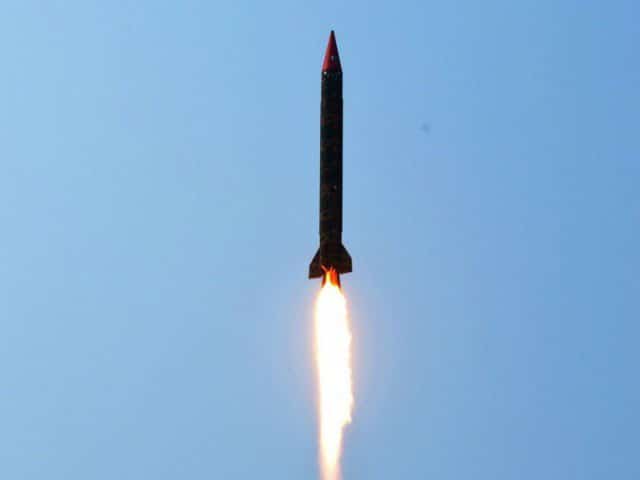khansaheeb
ELITE MEMBER

- Joined
- Dec 14, 2008
- Messages
- 17,009
- Reaction score
- -8
- Country
- Location

Ghauri (Hatf 5) | Missile Threat
The Ghauri (Hatf 5) is a Pakistani medium-range, road-mobile, liquid-fueled ballistic missile. It can carry a 700 kg warhead up to 1,500 km. Hatf 5’s range and nuclear capability give it the ability to hold targets deep within Indian territory at risk, making it a core part of Pakistan’s...
 missilethreat.csis.org
missilethreat.csis.org
Ghauri (Hatf 5)
Last Updated
August 2, 2021
The Ghauri (Hatf 5) is a Pakistani medium-range, road-mobile, liquid-fueled ballistic missile. It can carry a 700 kg warhead up to 1,500 km. Hatf 5’s range and nuclear capability give it the ability to hold targets deep within Indian territory at risk, making it a core part of Pakistan’s strategic missile forces.
Hatf 5 “Ghauri” at a Glance
ORIGINATED FROMNorth Korea / PakistanPOSSESSED BYPakistanCLASSMedium-Range Ballistic Missile (MRBM)BASINGRoad-mobileLENGTH15.9 mDIAMETER1.35 mLAUNCH WEIGHT15,850 kgPAYLOADSingle warhead, 700 kgWARHEAD12 – 35 kT nuclear, HE, submunitions, chemicalPROPULSIONSingle-stage liquid propellantRANGE1,250 – 1,500 kmSTATUSOperationalIN SERVICE2003 – present-
Hatf 5 test launch in October 2018. Photo: ISPR Pakistan

- Hatf 5 test launch. Photo: ISPR Pakistan

- Hatf 5 missile in launch position. Photo: FAS

Hatf 5 Development
The Hatf 5 is nearly identical in appearance to North Korea’s Nodong 1 MRBM.1 Cooperation between the two countries is documented throughout the 1980’s and 1990’s. Both North Korea and Pakistan exchanged delegations on several occasions during these years and reportedly discussed missile development. Pakistan received between 12-25 No Dong missiles from North Korea as a result of the cooperation.2 It also appears that the Hatf 5 was developed in conjunction with Iran, as the Iranian Shahab-3 missile appears very similar both in appearance and capabilities, and there is evidence all three countries have cooperated on these missile programs together since the 1980s.3 China may have provided additional support in the Hatf 5 development process, as it is believed that the Hatf 5’s guidance system is of Chinese origin.4The first flight test of the Hatf 5 took place in 1998, and the missile entered service in 2003.5
Hatf 5A / Ghauri 2
The Ghauri 2 is a medium-range, road-mobile, liquid propellant ballistic missile. It is a longer ranged variant of the Hatf 5, developed by replacing the heavier steel construction with an aluminum alloy and using improved propellants. It is expected to have a range of at least 1,800 km.6Specifications
The Hatf 5 can range between 1,250-1,500 km.7 It measures 15.9 m in length, 1.35 m in body diameter, with weighs 15,850 kg at launch. Its payload is a single separating warhead weighing up to 1,200 kg. The warhead can carry 700 kg, 12 to 35 kT yield nuclear weapon, chemical, HE, or submunitions. The reported accuracy of the Hatf 5 is 2,500 m CEP; however, it is possible that with an advanced Chinese guidance system, the CEP could be more accurate than reported.The Ghauri uses a single-stage liquid propellant engine. Liquid fuel can significantly increase launch preparation time, and can complicate storage and transportation.8 Like most Pakistani missile systems, the Hatf 5 is designed for launch from modified Russian ‘Scud-B’ Transporter-Erector-Launcher (TEL) vehicles. A modified battle tank is also known to have been used for a TEL vehicle.9 The mobility provided by these vehicles help make the missiles more difficult for enemy forces to locate and target.
Footnotes
CITE THIS PAGE
Missile Defense Project, "Ghauri (Hatf 5)," Missile Threat, Center for Strategic and International Studies, September 16, 2016, last modified August 2, 2021, https://missilethreat.csis.org/missile/hatf-5/.COPYRelated

NEWS
Pakistan Test Fires Hatf-5 Ballistic Missile
October 12, 2018Jenevieve Molenda
On October 8, the Pakistani Army Strategic Forces Command conducted a successful training launch of the Hatf-5 “Ghauri” medium-range ballistic missile. The launch was part of a readiness assessment of the Pakistani Strategic Forces. Hatf-5 is a road-mobile, liquid-fueled missile capable of carrying nuclear, high-explosive, chemical, or submunitions warhead. It entered service in 2003 and has...






